 W
WArctinurus boltoni is a large lichid trilobite of the mid-Silurian. This trilobite reached about eight inches in length, though the normal adult carapace was about four inches. It lived in moderately deep-water in semi-tropical regions. Arctinurus fossils have been found in Europe and North America. Arctinurus was first reported during the construction of the Erie Canal through soft Silurian shales and mudstones in upstate New York. Before the late 1990s, complete Arctinurus fossils were very rare. The vast majority of complete specimens were commercially mined near Middleport New York, USA, in a shallow quarry in the Rochester Formation, and the trilobite is now relatively common in museum, university and private collections. Arctinurus tended to have epibionts attached to the carapace.
 W
WAtrypa is a genus of brachiopod with shells round to short egg-shaped, covered with many fine radial ridges, that split further out and growthlines perpendicular to the costae and 2-3 times wider spaced. The pedunculate valve is a little convex, but tends to level out or even become slightly concave toward the anterior margin. The brachial valve is highly convex. There is no interarea in either valve. Atrypa was a cosmopolitan and occurred from the late Lower Silurian (Telychian) to the early Upper Devonian (Frasnian). Other sources expand the range from the Late Ordovician to Carboniferous, approximately from 449 to 336 Ma. A proposed new species, A. harrisi, was found in the trilobite-rich Floresta Formation in Boyacá, Colombia.
 W
WAulopora is an extinct genus of tabulate coral characterized by a bifurcated budding pattern and conical corallites. Colonies commonly encrust hard substrates such as rocks, shells and carbonate hardgrounds.
 W
WAviculopecten is an extinct genus of bivalve mollusc that lived from the Early Devonian to the Late Triassic in Asia, Australia, Europe, North America, and South America.
 W
WBellerophon is a genus of extinct paleozoic marine molluscs of uncertain position in the family Bellerophontidae.
 W
WCatenipora is an extinct genus of tabulate corals in the family Halysitidae, known from the Ordovician to the Silurian.
 W
WChonetes is an extinct genus of brachiopods. It ranged from the Late Ordovician to the Middle Jurassic.
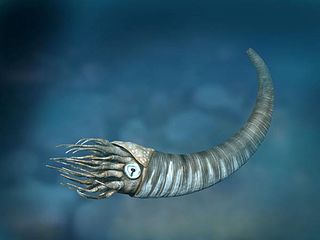 W
WCyrtoceras is an extinct genus of oncoceridan nautiloids that lived from the middle Ordovician to the middle Devonian, in Africa, Europe, North America and South America.
 W
WDiscoceras is an extinct marine cephalopod mollusk, a member of the Trocholitidae in the Tarphycerida. It is distinct from Discosorus, It is characterized by closely coiled, gradually expanding shells with a subquadrate cross section, that may be ribbed or smooth. The sides are broadly rounded; the venter is wide and slightly rounded. The maximum width is slightly dorsal of the middle. The dorsum has a slight to moderate impression. The siphuncle starts off central for the first half whorl then becomes marginodorsal in the succeeding two whorls, then subdorsal at maturity. As with Trocholites, the dorsal siphuncle in Discoceras probably indicates an orientation during life that places the back of the living chamber high in the shell.
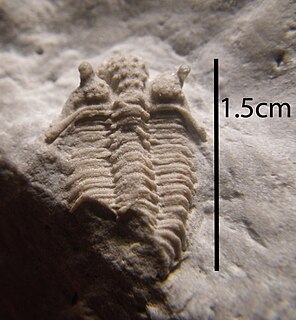 W
WEncrinurus is a long-lived genus of phacopid trilobites that lived in what are now Africa, Asia, Australia, Europe, North America, and South America from the middle Ordovician to the early Devonian from 472—412.3 mya, existing for approximately 59.7 million years .
 W
WEndoceras is an extinct genus of large, straight shelled cephalopods from the Middle and Upper Ordovician that gives its name to the Nautiliod order Endocerida. The cross section in the mature portion is slightly wider than high, but is narrower laterally in the young. Sutures are straight and transverse. Endoceras has a large siphuncle, located close to the ventral margin, composed of concave segments, especially in the young but which may be tubular in the adult stage. Endocones are simple, subcircular in cross section, and penetrated by a narrow tube which may contain diaphragms reminiscent of the Ellesmerocerid ancestor.
 W
WEuomphalus is a genus of fossil marine gastropods known to have lived from the Silurian to the Middle Permian.
 W
WFavosites is an extinct genus of tabulate coral characterized by polygonal closely packed corallites. The walls between corallites are pierced by pores known as mural pores which allowed transfer of nutrients between polyps. Favosites, like many corals, thrived in warm sunlit seas, feeding by filtering microscopic plankton with their stinging tentacles and often forming part of reef complexes. The genus had a worldwide distribution from the Late Ordovician to Late Permian.
 W
WGomphoceras is a questionable nautiloid cephalopod genus assigned to the Oncocerida. The family to which it might belong is undetermined.
 W
WGrewingkia is a genus of extinct Paleozoic corals, found in Indiana. It contains at least one species, Grewingkia canadensis.
 W
WHalysites is an extinct genus of tabulate coral. Colonies range from less than one to tens of centimeters in diameter, and they fed upon plankton.
 W
WHexagonaria is a genus of colonial rugose coral. Fossils are found in rock formations dating to the Devonian period, about 350 million years ago. Specimens of Hexagonaria can be found in most of the rock formations of the Traverse Group in Michigan. Fossils of this genus form Petoskey stones, the state stone of Michigan.They can be seen and found in most Midwestern states.
 W
WHolopea is an extinct genus of fossil sea snails, Paleozoic gastropod mollusks in the family Holopeidae.
 W
WIsotelus is a genus of asaphid trilobites from the middle and upper Ordovician period, fairly common in the Northeastern United States, northwest Manitoba, southwestern Quebec and southeastern Ontario. One species, Isotelus rex, is currently the world's largest trilobite ever found as a complete fossil.
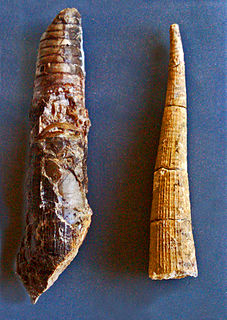 W
WKionoceras is an extinct nautiloid cephalopod genus included in the orthocerid family Kionoceratidae with scattered worldwide distribution from the Middle Ordovician to the Lower Permian. Kionoceratids are orthocerids with prominent longitudinal ornamentation on their shells, sometimes augmented by secondary transverse ornamenttion. Orthocerids are, of course, prehistoric nautiloides with generally straight and elongate shells, mostly with central or subcentral siphuncles.
 W
WLeptaena is an extinct genus of mid-sized brachiopod that existes from the Dariwilian epoch to the Emsian epoch, though some specimens have been found in strata as late in age as the Tournasian epoch. Like some other Strophomenids, Lepteana were epifaunal, meaning they lived on top of the seafloor, not buried within it, and were suspension feeders.
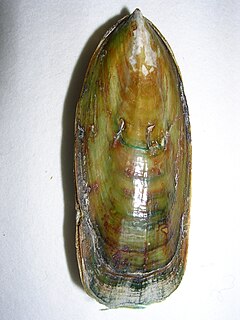 W
WLingula is a genus of brachiopods within the class Lingulata. Lingula or forms very close in appearance have existed possibly since the Cambrian. Like its relatives, it has two unadorned organo-phosphatic valves and a long fleshy stalk. Lingula lives in burrows in barren sandy coastal seafloor and feeds by filtering detritus from the water. It can be detected by a short row of three openings through which it takes in water (sides) and expels it again (middle).
 W
WMeristella is an extinct genus of brachiopods found from the Late Silurian to the Late Devonian. They are characterized by a smooth oval shell and a prominent incurved beak on the pedicle valve. Meristella is placed in the family Meristellidae of the articulate brachiopod order Athyridida.
 W
WNaticopsis is an extinct genus of small sea snails belonging to the family Neritopsidae.
 W
WOrmoceras is an actinocerid nautiloid genus and type for the family Ormoceratidae, found in North America from the late Chazyan through the early Cincinnatian of the Middle and Upper Ordovician, but which continued through the Devonian worldwide.
 W
WPentamerus is a prehistoric genus of brachiopods that lived from the Silurian to the Middle Devonian in Asia, Europe, and North America.
 W
WPlaesiomys is a genus of extinct lamp shells belonging to the family Plaesiomyidae.
 W
WPlatyceras is a genus of extinct Paleozoic sea snails, marine gastropod mollusks in the family Platyceratidae. This genus is known from the Silurian to the Middle Triassic periods and especially abundant in the Devonian and Carboniferous. It is the type genus of the family Platyceratidae.
 W
WPlatystrophia is an extinct genus of brachiopods that lived from the Ordovician to the Silurian in Asia, Europe, North America, and South America. It has a prominent sulcus and fold. It usually lived in marine lime mud and sands.
 W
WRafinesquina is an extinct genus of large brachiopod that existed from the Darriwilian to the Ludlow epoch.
 W
WReceptaculites is the name-bearing genus for an extinct group of conspicuous benthic marine genera, the Receptaculitidae, that lived from the Early Ordovician through the Permian period, peaking in the Middle Ordovician. The group's phylogenetic origin has long been obscure, but the current understanding is that the Receptaculitidae were calcareous algae, probably of the Order Dasycladales. Receptaculitids lived in warm, shallow seas and have been described from all continents except Antarctica. In some areas they were important reef-formers, and they also occur as isolated specimens.
 W
WSpirorhaphe is an ichnogenus of spiraling burrows. It is associated with the Nereites ichnofacies, which is interpreted as an indicator of deep-sea, pelagic, turbidity current-dominated systems. It is one of the most common graphoglyptid traces found in modern ocean beds.
 W
WStringocephalus is an extinct genus of large brachiopods; between 388.1 to 376.1 million years old they are usually found as fossils in Devonian marine rocks. Several forms of the genus are known; they may be found in western North America, northern Europe, Asia and the Canning Basin of Western Australia. Several different types are known; they share a well-developed, curved structure shaped like a beak. Some of the largest specimens discovered to date have been found in China.
 W
WStrophomena is a genus of brachiopods belonging to the order Strophomenida family Strophomenidae, named by Rafinesque in 1824. They were stationary epifaunal suspension feeders.
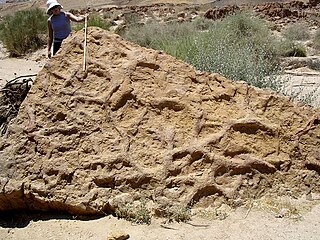 W
WThalassinoides is an ichnogenus of trace fossil used to refer to "dichotomously or T-branched boxworks, mazes and shafts, unlined and unornamented". Facies of Thalassinoides increased suddenly in abundance at the beginning of the Mesozoic. Such burrows are made by a number of organisms, including the sea anemone Cerianthus, Balanoglossus and fishes, but are most closely associated with decapod crustaceans of the (former) infraorder Thalassinidea.
 W
WTrypanites is a narrow, cylindrical, unbranched boring which is one of the most common trace fossils in hard substrates such as rocks, carbonate hardgrounds and shells. It appears first in the Lower Cambrian, was very prominent in the Ordovician Bioerosion Revolution, and is still commonly formed today. Trypanites is almost always found in calcareous substrates, most likely because the excavating organism used an acid or other chemical agent to dissolve the calcium carbonate. Trypanites is common in the Ordovician and Silurian hardgrounds of Baltica.